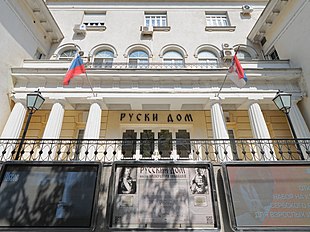The Russian House — Russian Centre of Science and Culture in Belgrade (Russian: Российский центр науки и культуры «Русский дом», Serbian: Руски центар за науку и културу „Руски дом“) is a centre aimed to promote Russian language and culture, it is one of 44 present Russian Cultural Centers worldwide.[1]
| The Russian House | |
|---|---|
 General view of The Russian House | |
 | |
| Former names | Emperor Nicholas II's Russian House (1933-45) House of Soviet culture (1945-94) |
| Alternative names | Russian Center of Science and Culture |
| General information | |
| Type | Public building |
| Architectural style | neoclassicism |
| Location | Serbia, Belgrade, Stari Grad |
| Address | Belgrade, Queen Natalia str., 33 |
| Coordinates | 44°48′34″N 20°27′40″E / 44.8095°N 20.461°E |
| Construction started | June 22, 1931 |
| Inaugurated | April 9, 1933 |
| Owner | Rossotrudnichestvo of Russian Ministry of Foreign Affairs |
| Technical details | |
| Floor count | 4 |
| Design and construction | |
| Architect(s) | Vasily Baumgarten |
| Renovating team | |
| Architect(s) | Grigoriy Samoylov |
| Website | |
| www | |
Establishment of the Russian Center is strongly connected to Russian emigrants in the Kingdom of Yugoslavia, after 1917 October Revolution.[1] Idea for establishment comes from these emigrants, and it has been affirmed by King Alexander, Serbian Patriarch Varnava, Aleksandar Belić and other famous persons from Serbia.
Center is finished by the project of Vasily Baumgarten, talented Russian architect. It is opened as cultural center on 9 April 1933. Today, it is reputable as one of the most beautiful locations in Belgrade.[1]
In the post World War II period, Center is turned to the Home of Soviet Culture. Since 1994 to present it has been named Russian Center of Science and Culture — The Russian House.
References
edit- ^ a b c Ruski centar za nauku i kulturu „Ruski dom“ u Beogradu.RuskiDom.rs Russian Home.
External links
editMedia related to Ruski Dom, Belgrade at Wikimedia Commons
- Official website
- Russian Center on the official website of Serbian Government